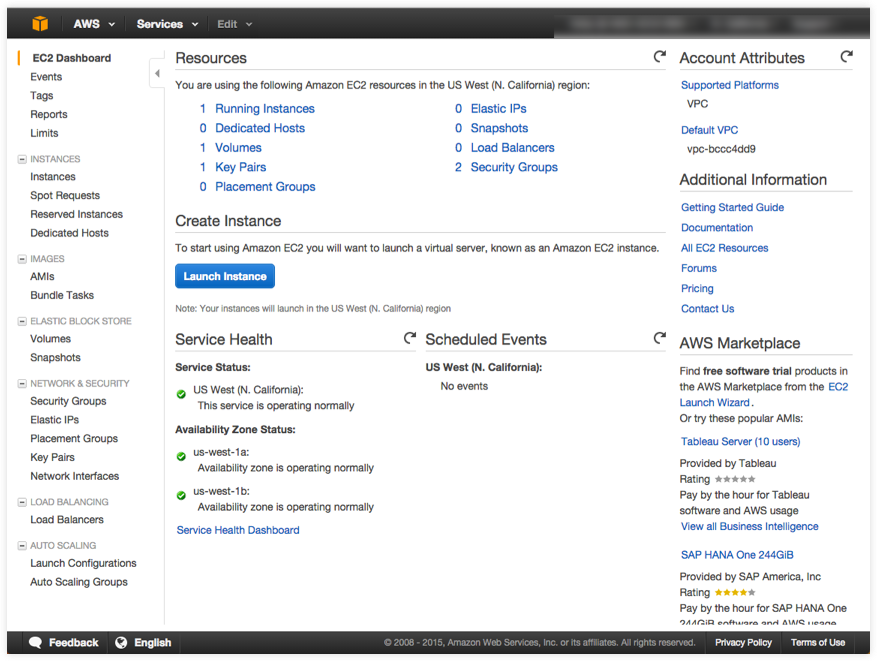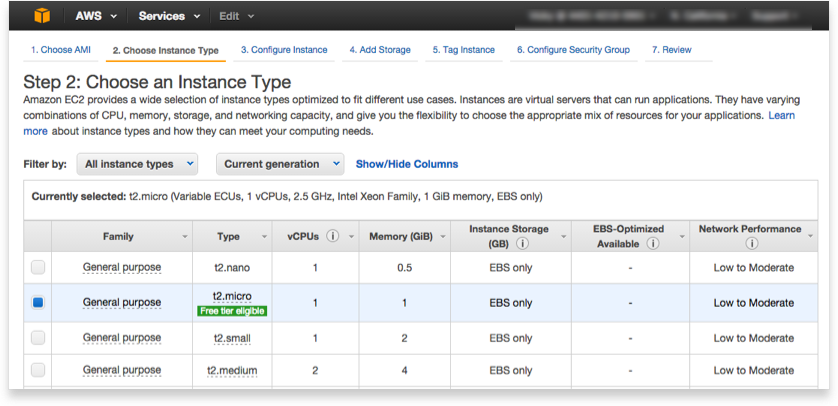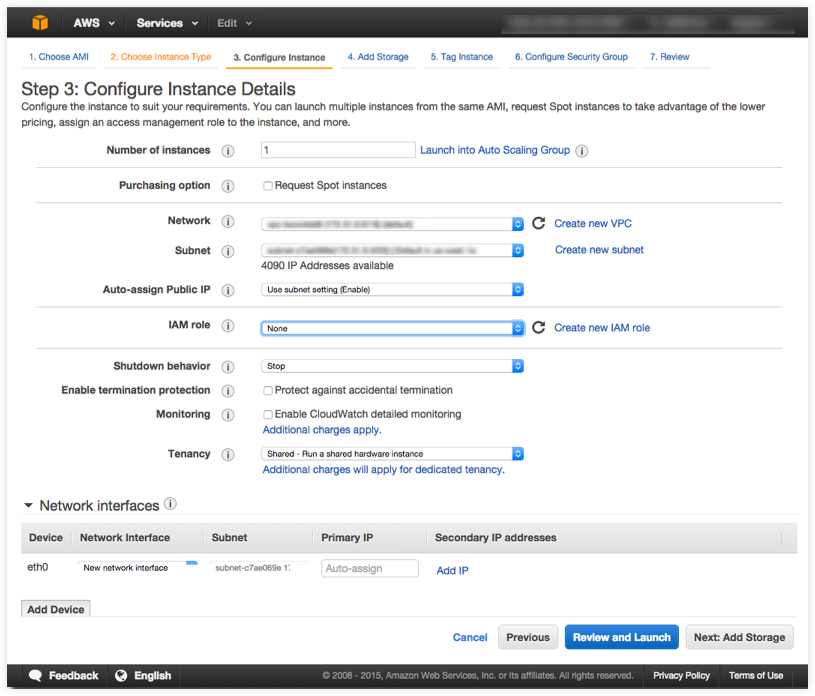github.com/hustcat/docker@v1.3.3-0.20160314103604-901c67a8eeab/docs/installation/cloud/cloud-ex-aws.md (about) 1 <!--[metadata]> 2 +++ 3 title = "Example: Manual install on cloud provider" 4 description = "Example of a manual install of Docker Engine on a cloud provider, using Amazon Web Services (AWS) EC2. Shows how to create an EC2 instance, and install Docker Engine on it." 5 keywords = ["cloud, docker, machine, documentation, installation, AWS, EC2"] 6 [menu.main] 7 parent = "install_cloud" 8 +++ 9 <![end-metadata]--> 10 11 # Example: Manual install on cloud provider 12 13 You can install Docker Engine directly to servers you have on cloud providers. This example shows how to create an <a href="https://aws.amazon.com/" target="_blank"> Amazon Web Services (AWS)</a> EC2 instance, and install Docker Engine on it. 14 15 You can use this same general approach to create Dockerized hosts on other cloud providers. 16 17 ### Step 1. Sign up for AWS 18 19 1. If you are not already an AWS user, sign up for <a href="https://aws.amazon.com/" target="_blank"> AWS</a> to create an account and get root access to EC2 cloud computers. If you have an Amazon account, you can use it as your root user account. 20 21 2. Create an IAM (Identity and Access Management) administrator user, an admin group, and a key pair associated with a region. 22 23 From the AWS menus, select **Services** > **IAM** to get started. 24 25 See the AWS documentation on <a href="http://docs.aws.amazon.com/AWSEC2/latest/UserGuide/get-set-up-for-amazon-ec2.html" target="_blank">Setting Up with Amazon EC2</a>. Follow the steps for "Create an IAM User" and "Create a Key Pair". 26 27 If you are just getting started with AWS and EC2, you do not need to create a virtual private cloud (VPC) or specify a subnet. The newer EC2-VPC platform (accounts created after 2013-12-04) comes with a default VPC and subnet in each availability zone. When you launch an instance, it automatically uses the default VPC. 28 29 ### Step 2. Configure and start an EC2 instance 30 31 Launch an instance to create a virtual machine (VM) with a specified operating system (OS) as follows. 32 33 1. Log into AWS with your IAM credentials. 34 35 On the AWS home page, click **EC2** to go to the dashboard, then click **Launch Instance**. 36 37  38 39 AWS EC2 virtual servers are called *instances* in Amazon parlance. Once you set up an account, IAM user and key pair, you are ready to launch an instance. It is at this point that you select the OS for the VM. 40 41 2. Choose an Amazon Machine Image (AMI) with the OS and applications you want. For this example, we select an Ubuntu server. 42 43  44 45 3. Choose an instance type. 46 47  48 49 4. Configure the instance. 50 51 You can select the default network and subnet, which are inherently linked to a region and availability zone. 52 53  54 55 5. Click **Review and Launch**. 56 57 6. Select a key pair to use for this instance. 58 59 When you choose to launch, you need to select a key pair to use. Save the `.pem` file to use in the next steps. 60 61 The instance is now up-and-running. The menu path to get back to your EC2 instance on AWS is: **EC2 (Virtual Servers in Cloud)** > **EC2 Dashboard** > **Resources** > **Running instances**. 62 63 To get help with your private key file, instance IP address, and how to log into the instance via SSH, click the **Connect** button at the top of the AWS instance dashboard. 64 65 66 ### Step 3. Log in from a terminal, configure apt, and get packages 67 68 1. Log in to the EC2 instance from a command line terminal. 69 70 Change directories into the directory containing the SSH key and run this command (or give the path to it as part of the command): 71 72 $ ssh -i "YourKey" ubuntu@xx.xxx.xxx.xxx 73 74 For our example: 75 76 $ cd ~/Desktop/keys/amazon_ec2 77 $ ssh -i "my-key-pair.pem" ubuntu@xx.xxx.xxx.xxx 78 79 We'll follow the instructions for installing Docker on Ubuntu at https://docs.docker.com/engine/installation/ubuntulinux/. The next few steps reflect those instructions. 80 81 2. Check the kernel version to make sure it's 3.10 or higher. 82 83 ubuntu@ip-xxx-xx-x-xxx:~$ uname -r 84 3.13.0-48-generic 85 86 3. Add the new `gpg` key. 87 88 ubuntu@ip-xxx-xx-x-xxx:~$ sudo apt-key adv --keyserver hkp://p80.pool.sks-keyservers.net:80 --recv-keys 58118E89F3A912897C070ADBF76221572C52609D 89 Executing: gpg --ignore-time-conflict --no-options --no-default-keyring --homedir /tmp/tmp.jNZLKNnKte --no-auto-check-trustdb --trust-model always --keyring /etc/apt/trusted.gpg --primary-keyring /etc/apt/trusted.gpg --keyserver hkp://p80.pool.sks-keyservers.net:80 --recv-keys 58118E89F3A912897C070ADBF76221572C52609D 90 gpg: requesting key 2C52609D from hkp server p80.pool.sks-keyservers.net 91 gpg: key 2C52609D: public key "Docker Release Tool (releasedocker) <docker@docker.com>" imported 92 gpg: Total number processed: 1 93 gpg: imported: 1 (RSA: 1) 94 95 4. Create a `docker.list` file, and add an entry for our OS, Ubuntu Trusty 14.04 (LTS). 96 97 ubuntu@ip-xxx-xx-x-xxx:~$ sudo vi /etc/apt/sources.list.d/docker.list 98 99 If we were updating an existing file, we'd delete any existing entries. 100 101 5. Update the `apt` package index. 102 103 ubuntu@ip-xxx-xx-x-xxx:~$ sudo apt-get update 104 105 6. Purge the old repo if it exists. 106 107 In our case the repo doesn't because this is a new VM, but let's run it anyway just to be sure. 108 109 ubuntu@ip-xxx-xx-x-xxx:~$ sudo apt-get purge lxc-docker 110 Reading package lists... Done 111 Building dependency tree 112 Reading state information... Done 113 Package 'lxc-docker' is not installed, so not removed 114 0 upgraded, 0 newly installed, 0 to remove and 139 not upgraded. 115 116 7. Verify that `apt` is pulling from the correct repository. 117 118 ubuntu@ip-172-31-0-151:~$ sudo apt-cache policy docker-engine 119 docker-engine: 120 Installed: (none) 121 Candidate: 1.9.1-0~trusty 122 Version table: 123 1.9.1-0~trusty 0 124 500 https://apt.dockerproject.org/repo/ ubuntu-trusty/main amd64 Packages 125 1.9.0-0~trusty 0 126 500 https://apt.dockerproject.org/repo/ ubuntu-trusty/main amd64 Packages 127 . . . 128 129 From now on when you run `apt-get upgrade`, `apt` pulls from the new repository. 130 131 ### Step 4. Install recommended prerequisites for the OS 132 133 For Ubuntu Trusty (and some other versions), it’s recommended to install the `linux-image-extra` kernel package, which allows you use the `aufs` storage driver, so we'll do that now. 134 135 ubuntu@ip-xxx-xx-x-xxx:~$ sudo apt-get update 136 ubuntu@ip-172-31-0-151:~$ sudo apt-get install linux-image-extra-$(uname -r) 137 138 ### Step 5. Install Docker Engine on the remote instance 139 140 1. Update the apt package index. 141 142 ubuntu@ip-xxx-xx-x-xxx:~$ sudo apt-get update 143 144 2. Install Docker Engine. 145 146 ubuntu@ip-xxx-xx-x-xxx:~$ sudo apt-get install docker-engine 147 Reading package lists... Done 148 Building dependency tree 149 Reading state information... Done 150 The following extra packages will be installed: 151 aufs-tools cgroup-lite git git-man liberror-perl 152 Suggested packages: 153 git-daemon-run git-daemon-sysvinit git-doc git-el git-email git-gui gitk 154 gitweb git-arch git-bzr git-cvs git-mediawiki git-svn 155 The following NEW packages will be installed: 156 aufs-tools cgroup-lite docker-engine git git-man liberror-perl 157 0 upgraded, 6 newly installed, 0 to remove and 139 not upgraded. 158 Need to get 11.0 MB of archives. 159 After this operation, 60.3 MB of additional disk space will be used. 160 Do you want to continue? [Y/n] y 161 Get:1 http://us-west-1.ec2.archive.ubuntu.com/ubuntu/ trusty/universe aufs-tools amd64 1:3.2+20130722-1.1 [92.3 kB] 162 Get:2 http://us-west-1.ec2.archive.ubuntu.com/ubuntu/ trusty/main liberror-perl all 0.17-1.1 [21.1 kB] 163 . . . 164 165 3. Start the Docker daemon. 166 167 ubuntu@ip-xxx-xx-x-xxx:~$ sudo service docker start 168 169 4. Verify Docker Engine is installed correctly by running `docker run hello-world`. 170 171 ubuntu@ip-xxx-xx-x-xxx:~$ sudo docker run hello-world 172 ubuntu@ip-172-31-0-151:~$ sudo docker run hello-world 173 Unable to find image 'hello-world:latest' locally 174 latest: Pulling from library/hello-world 175 b901d36b6f2f: Pull complete 176 0a6ba66e537a: Pull complete 177 Digest: sha256:8be990ef2aeb16dbcb9271ddfe2610fa6658d13f6dfb8bc72074cc1ca36966a7 178 Status: Downloaded newer image for hello-world:latest 179 180 Hello from Docker. 181 This message shows that your installation appears to be working correctly. 182 183 To generate this message, Docker took the following steps: 184 1. The Docker client contacted the Docker daemon. 185 2. The Docker daemon pulled the "hello-world" image from the Docker Hub. 186 3. The Docker daemon created a new container from that image which runs the executable that produces the output you are currently reading. 187 4. The Docker daemon streamed that output to the Docker client, which sent it to your terminal. 188 189 To try something more ambitious, you can run an Ubuntu container with: 190 $ docker run -it ubuntu bash 191 192 Share images, automate workflows, and more with a free Docker Hub account: 193 https://hub.docker.com 194 195 For more examples and ideas, visit: 196 https://docs.docker.com/userguide/ 197 198 ## Where to go next 199 200 _Looking for a quicker way to do Docker cloud installs and provision multiple hosts?_ You can use [Docker Machine](https://docs.docker.com/machine/overview/) to provision hosts. 201 202 * [Use Docker Machine to provision hosts on cloud providers](https://docs.docker.com/machine/get-started-cloud/) 203 204 * [Docker Machine driver reference](https://docs.docker.com/machine/drivers/) 205 206 * [Install Docker Engine](../index.md) 207 208 * [Docker User Guide](../../userguide/intro.md)